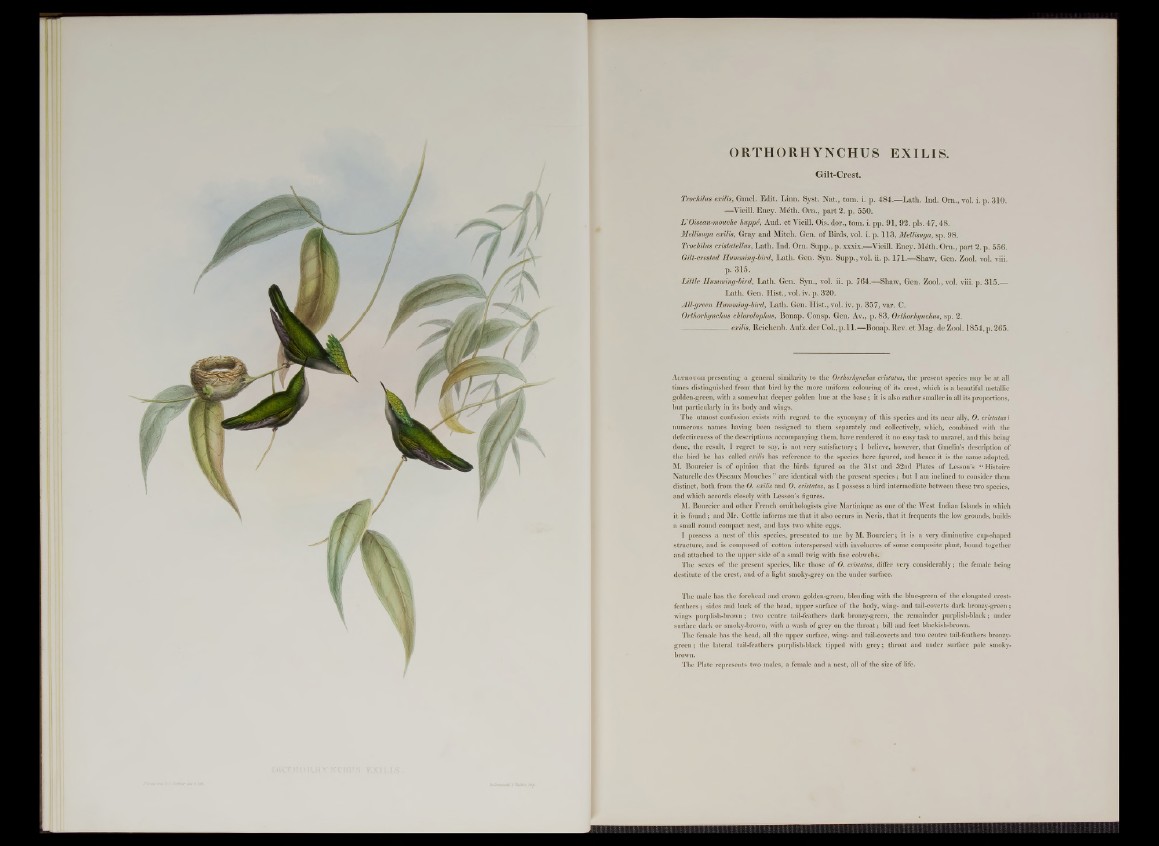
ORTHORHYNCHUS EXILIS.
Gilt-Crest.
Ti'ochilus earilis, Gmel. Edit. Linn. Syst. N a t., tom. i. p. 484.—Lath. Ind. Om., vol. i. p. 310.
—Vieill. Ency. M£th. Om., p a rt 2. p. 550.
L Oiseau-mouche huppe, Aud. e t Vieill. Ois. dor., tom. i. p p . 91, 92. pis. 4 7 ,4 8 .
Mellisuga earilis, Gray and Mitch. Gen. o f Birds, vol. i. p. 113, Mellisuga, sp. 98.
Trochilus cristatellus, L a th . Ind. Om. Supp., p. xxxix.—Vieill. Ency. M&h. Om., p a rt 2. p. 556.
Gilt-crested Humming-bird, L a th . Gen. Syn. Supp., vol. ii. p. 171.—Shaw, Gen. Zool. vol. viii.
p. 315.
L ittle Humming-bird, L a th . Gen. Syn., vol. ii. p. 764.— Shaw, Gen. Zool., vol. viii. p. 315.—
L a th . Gen. H ist., vol. iv. p. 320.
All-green Humming-bird, Lath. Gen. Hist., vol. iv. p. 357, var. C.
Orthorhynchus chlorolophus, Bonap. Consp. Gen. Av., p. 83, Orthorhynchus, sp. 2.
------------------earilis, Reichenb. Aufz. der Col., p. 11.—Bonap. Rev. e t Mag. de Zool. 1854, p. 265.
Although presenting a general similarity to the Orthorhynchus cristatus, the present species may be a t all
times distinguished from' th at bird by the more uniform colouring o f its crest, which is a beautiful metallic
golden-green, with a somewhat deeper golden hue a t the b a se ; it is also rather smaller in all its proportions,
but particularly in its body and wings.
The utmost confusion exists with regard to the synonymy of this species and its near ally, 0 . cristatus i
numerous names having been assigned to them separately and collectively, which, combined with the
defectiveness of the descriptions accompanying them, have rendered it no easy task to unravel, and this being
done, the result, I regret to say, is not very satisfactory; I believe, however, that Gmelin’s description of
the bird he has called exilis has reference to the species here figured, and hence it is the name adopted.
M. Bourcier is of opinion that the birds figured on the 31st and 32nd Plates of Lesson’s “ Histoire
Naturelle des Oiseaux Mouches ” are identical with the present species; but I am inclined to consider them
distinct, both from the 0 . eaiilis and 0. cristatus, as I possess a bird intermediate between these two species,
and which accords closely with Lesson’s figures.
M. Bourcier and other French ornithologists give Martinique as one of the West Indian Islands in which
it is found; and Mr. Cottle informs me that it also occurs in Nevis, that it frequents the low grounds, builds
a small round compact nest, and lays two white eggs.
I possess a nest of this species, presented to me by M. Bourcier; it is a very diminutive cup-shaped
structure, and is composed of cotton interspersed with involucres of some composite plant, bound together
and attached to the upper side of a small twig with fine cobwebs.
The sexes of the present species, like those of 0. cristatus, differ very considerably; the female being
destitute of the crest, and of a light smoky-grey on the under surface.
The male lias the forehead and crown golden-green, blending with the blue-green of the elongated crest-
feathers; sides and back of the head, upper surface of the body, wing- and tail-coverts dark bronzy-green;
wings purplish-brown; two centre tail-feathers dark bronzy-green, the remainder purplish-black; under
surface dark or smoky-brown, with a wash of grey on the throat; bill and feet blackish-brown.
The female has the head, all the upper surface, wing- and tail-coverts and two centre tail-feathers bronzy-
green ; the lateral tail-feathers purplish-black tipped with grey; throat and under surface pale smoky-
brown.
The Plate represents two males, a female and a nest, all of the size of life.